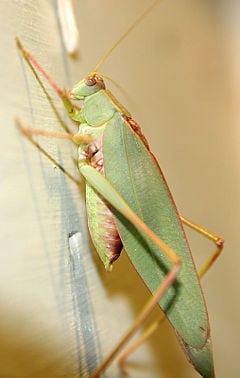Ensifera
| Ensifera
| ||||||||||
|---|---|---|---|---|---|---|---|---|---|---|
 Katydid
| ||||||||||
| Scientific classification | ||||||||||
| ||||||||||
|
Ensifera is a suborder of the order Orthoptera, comprising "long-horned" orthopterans commonly known as crickets, katydids (or bush crickets) and weta, and characterized in extant members by long, fine, and threadlike antennae that have well over 30 segments and can reach several times the body length. "Ensifer" means "sword bearer" in Latin, and refers to the typically elongated and blade-like ovipositor of the females, although several taxa have a reduced or absent ovipositor. There are more than 11,000 described species in Ensifera.
Members of Ensifera are sometimes collectively known as "long-horned grasshoppers" although this designation often is limited to members of the family Tettigoniidae (the katydids, also called bush crickets in some countries) and not the crickets or weta. More commonly, the designation grasshopper itself refers to members of the orthopteran suborder Caelifera, also known as "short-horned grasshoppers."
Ensiderans are particularly well known as singing insects, with the males calling mates via stridulation, either involving rubbing together portions of their forewings (katydids and crickets) or a femur-abdominal mechanism (some weta).
Overview and description
As members of the insect order Orthoptera, ensiferans are characterized by chewing/biting mouthparts, incomplete metamorphosis (hemimetabolism), strong hind limbs for leaping, and two pairs of wings that are held overlapping the abdomen at rest. The forewings are narrower than the hindwings and hardened at the base, while the hindwings are membranous and folded fan-like under the forewings when at rest.
Orthoptera includes two suborders, Caelifera (short-horned grasshoppers and locusts) and Ensifera (crickets, katydids, and weta). The Ensifera, sometimes collectively known as "long-horned grasshoppers" (Naskrecki 2004), are typified by antennae longer than the body, while the Caelifera have antennae shorter than the body. Characteristics of Ensifera include fine and threadlike antennae with well over 30 segments (except the fossorial Cooloolidae), a sword-like or needle-like six-valved ovipositor (when present), and elongate mandibles with a prominent incisor (Gwynne and Desutter 1996). In singing families, there are stidulatory specializations of the forewings to make sounds and the auditory organs (when present) linked via modified tracheae to the enlarged mesothoracic spiracles. Members of both Caelifera and Ensifera are primarily herbivorous species, but Ensifera includes a few carnivorous species.
Auditory organs are on the abdomen, unlike on the forelegs of the family Tettigoniidae. The true grasshoppers produce sounds by rubbing their legs against the abdomen, and there may also be a visual display.
The males of katydids have sound-producing organs (via stridulation) located on the hind angles of their front wings,
Behavior and reproduction
Behaviorally, members of Ensifera tend to be largely nocturnal (versus the more diurnal Caelifera)
Diurnal activity is prevalent in the short-horned grasshoppers, when they feed and mate, with nighttime activities including molting and egg laying (Grizmek et al. 2004). This is in contrast to katydids and crickets, which tend to be nocturnal (Grzimek et al. 2004).
Classification
The taxonomy of the suborder Ensifera is not settled. Naskrecki (2004) recognizes 11,000 described species placed in approximately 1,900 genera, 21 families, and 6 superfamilies. The largest subfamily was Tettigonioidea, comprising the kaydids (or bush-crickets), with over 7,000 known species and placed in 1,000 genera. Naskrecki (2004) also recognizes the superfamilies Grylloidea (crickets), with over 3,500 species and 500 genera, Stenopelmatoidea (Jerusalem and camel crickets), Gryullotalpoidea (mole crickets), the Mogoplistoidea (scale crickets), and the Hagloidea (grips or humb-winged crickets).
The classification of the suborder was drastically revised in December 2005 by the Orthopterists' Society. The following is a more recent taxonomic scheme
Extant Superfamilies and families
- Superfamily Grylloidea
- Gryllidae - true crickets
- Gryllotalpidae - mole crickets
- Mogoplistidae
- Myrmecophilidae - ant crickets
- Superfamily Hagloidea
- Prophalangopsidae
- Superfamily Rhaphidophoroidea
- Rhaphidophoridae - camel crickets, cave crickets, cave wetas
- Superfamily Schizodactyloidea
- Schizodactylidae - dune crickets
- Superfamily Stenopelmatoidea
- Anostostomatidae - wetas, king crickets
- Cooloolidae
- Gryllacrididae - leaf-rolling crickets
- Stenopelmatidae - Jerusalem crickets
- Superfamily Tettigonioidea
- Tettigoniidae - katydids, koringkrieks
ReferencesISBN links support NWE through referral fees
- Naskrecki, P. 2004. Orthoptera. In B. Grzimek, D. G. Kleiman, V. Geist, and M. C. McDade, Grzimek's Animal Life Encyclopedia. Detroit: Thomson-Gale. ISBN 0787657883.
- Gwynne, D. T. and G. K. Morris. 2002. Tettigoniidae. Katydids, Long-horned grasshoppers and bushcrickets. Tree of Life Web Project Version 26 November 2002. Retrieved November 10, 2008.
- Gwynne, D. T. and L. DeSutter. 1996. Ensifera. Crickets, katydids and weta. Tree of Life Web Project Version 01 January 1996. Retrieved November 10, 2008.
- Gwynne, D. T., L. DeSutter, P. Flook, and H. Rowell. 1996. Orthoptera. Crickets, kaytdids, grasshoppers, etc.. Tree of Life Web Project Version 01 January 1996. Retrieved November 10, 2008.
External links
Credits
New World Encyclopedia writers and editors rewrote and completed the Wikipedia article in accordance with New World Encyclopedia standards. This article abides by terms of the Creative Commons CC-by-sa 3.0 License (CC-by-sa), which may be used and disseminated with proper attribution. Credit is due under the terms of this license that can reference both the New World Encyclopedia contributors and the selfless volunteer contributors of the Wikimedia Foundation. To cite this article click here for a list of acceptable citing formats.The history of earlier contributions by wikipedians is accessible to researchers here:
The history of this article since it was imported to New World Encyclopedia:
Note: Some restrictions may apply to use of individual images which are separately licensed.